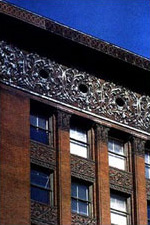Definition of the the Language of Art and Architecture
Overview
Within This Page
- Overview
- Additional Resources
In the late 19th century, Chicago builder Louis Sullivan wrote, "Form follows role." This dictum became one of the rallying cries of modern blueprint in the 20th century, and it remains ane of the best-known compages aphorisms today.
What Sullivan implied was that a edifice's grade is a natural effect of functional requirements. For many, the statement seemed to advocate for pure utilitarianism in manner.

Detail of Louis Sullivan's Wainwright Building—St. Louis, MO
But even a cursory expect at Sullivan's own architecture reveals some of the greatest ornamentation in American architecture. That observation lends weight to a counterargument:(*) that in that location are multiple ways of meeting the same function (getting people from the start floor to the 2d; bringing light into a room; making a hinge). Once i of those pathways has been selected, aesthetic considerations come into play. The architect is responsible for resolving all these elements into a singular edifice design.
From pre-Colombian civilizations and medieval times through today, people have synthetic public monuments and private structures to provide shelter, ease daily survival, or expedite governance. And in every period these functional buildings have also embodied their cultures' principles of dazzler—and, peradventure less explicitly, their underlying beliefs concerning spirituality, power structures, or civic engagement. Only put, they take fulfilled roles and engaged aesthetics simultaneously. One should also keep in mind that architectural expression is constrained or, in some cases, shaped by by technical, economic, and social weather.
Conceiving buildings in the nowadays twenty-four hours, then, would seem especially difficult. Shifting cultural values provide only tentative benchmarks for assessment, and visual manifestations of those values—in other words, styles—are fifty-fifty less concrete. All the same, there have been attempts to codify standards of contemporary aesthetic achievement. Visual limerick is taught in schools, for case. In addition, attempts at conceptual standards include the Guiding Principles for Federal Architecture, which President Kennedy signed in 1962. Among other things, the guiding principles advocate that public buildings reflect the dignity, enterprise, vigor, and stability of the federal authorities, while embodying the finest contemporary architectural thought; avoid an official fashion and limited the spirit of the locality; ensure physical accessibility to all people; and incorporate the work of living American artists. In other words, the certificate advises architects to embrace democratic values, seek out innovation and individuality, and provide outlet for multiple expressions of creativity.
The Language of Aesthetics
It is relatively easy to determine whether a given design contains the necessary square footage or the right number of rooms. Yet the complex nature of aesthetics makes for a more difficult chat. To assistance in this process, architects and designers share a vocabulary that helps them reduce complex ideas into short phrases. This terminology allows a projection squad'south members to understand and communicate well visually and verbally to produce successful solutions. Moreover, terminology helps clients and edifice users to better understand aesthetics as architectural linguistic communication: The way in which an private architect or whole civilisation expresses values is in the way individual words become forms, and in the mode those tangible parts are put together are sentence construction and grammar.
While it is not an exhaustive list of blueprint vocabulary, below yous volition find brief descriptions of fundamental design elements.
The Church building of Santa Maria Novella in Florence, Italy dating between 1456 to 1470 is a bully instance of Gothic architecture with an Italian Renaissance façade by Leon Batista Alberti.
Archetypical Building Elements
- Vertical:
- Wall, Arch, Beam Lintel, Quoin, Column, Orders
- Base, Shaft, Uppercase
- Window, Door
- Horizontal:
- Plinth, Flooring, Roof
Manner
Manner is a distinctive manner of expression or style at a specific time in history. In architecture, historical styles are often designated past a specific name such as Baroque, Victorian, or the International Style, to proper noun a few.
Form
Mass and shape define course. Mass refers to the volume defined by a structure relative to its surroundings and to its solidity and weight. Shape is the composition and complexity of the surface planes.
Materials
Both exterior and interior building materials should be selected based upon their appropriateness for the edifice blazon, immovability, affect on the environment, climatic conditions, and the prevailing architectural pattern and graphic symbol of the installation.
Boosted Resource
Useful introductions to architectural design, the design process, and design conclusion making include the following:
Publications
- Architecture: Form, Infinite, and Guild, 4th Edition by Francis D.Yard. Ching. New York, NY: John Wiley & Sons, 2014.
- The Compages of the Well-Tempered Environment by Reyner Banham. Chicago: The University of Chicago Press, 1969.
- Experiencing Compages by Southward.Eastward. Rasmussen. London, England: Chapman & Hall Ltd, 1959.
- How Buildings Learn by Stewart Brand. New York, NY: Viking. 1994.
- *The Nature of Blueprint by David Pye. London, England: Studio Vista, 1964.
- A Pattern Language by Christopher Alexander, Sara Ishikawa, Murray Silverstein, with Max Jacobson, Ingrid Fiksdahl-King, and Shlomo Angel. Oxford University Press, 1977.
- Precedents in Compages: Analytic Diagrams, Formative Ideas, and Partis, 4th Edition by Roger H. Clark and Michael Intermission. Hoboken, New Jersey: Wiley, 2012.
- The Two Cultures and the Scientific Revolution by C.P. Snow. New York, NY: Cambridge Academy Press, 1959.
Glossary of Architecture Terms
- Art & Architecture Thesaurus Online
- Illustrated Architecture Dictionary
Architectural Websites
- Arch Daily
- Archinect
- Architect
skirvingaboughtters.blogspot.com
Source: https://www.wbdg.org/design-objectives/aesthetics/understanding-language-elements-design